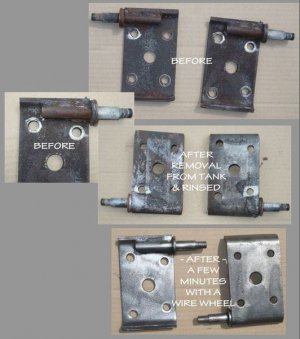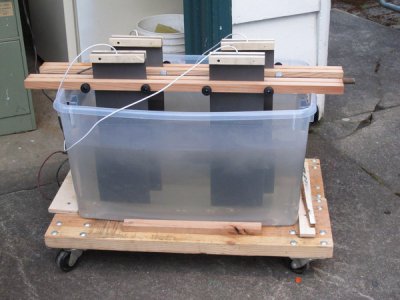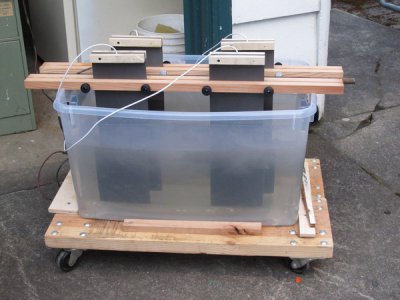- Joined
- Apr 28, 2014
- Messages
- 3,590
So, still don't have the Birmingham running what with this Jeep project. Man oh man reliving your youth is expensive... 
Anyway, any 40 year old Jeep is more rust than metal and I'm tackling changing the front springs and putting bushings
at all (4) corners. Figured I'd buy new Plates, Shackles, 'U'-bolts and fasteners this time around, riiiiiiiiiiiiight.
Then the reality of $$$$ and the fact that a lot of the hardware is imported - I decided to re-use.
I bought a new set of springs for the front and the box they arrived in stated "Made in Taiwan". I figure oh good they
should be decent - they were far from it. Pure junk, bad really bad, sent them back.
Which leads us to rust removal. Decided to try the electrolytic method. Finally put together a tank yesterday and fired it up.
(30) Gallon barrel, (6) Ø3/4 rebar as anodes, Soda Ash (Sodium Carbonate), 10AMP old Craftsman Battery Charger,
GFCI Ext. Cord, Rubber Gloves, Eye Protection, Hops/Barley Concoction for parts loader...
Used the Front Spring Plates for the first run. (14) Hours cook time. Gotta figure out the 'Line of Sight' of the rebar. Missed a couple of places.
As soon as I get this down pat, the lathes chucks are going in! I've got this one big arse 3-jaw that's complete rust, should be interesting.
_Dan

Anyway, any 40 year old Jeep is more rust than metal and I'm tackling changing the front springs and putting bushings
at all (4) corners. Figured I'd buy new Plates, Shackles, 'U'-bolts and fasteners this time around, riiiiiiiiiiiiight.
Then the reality of $$$$ and the fact that a lot of the hardware is imported - I decided to re-use.
I bought a new set of springs for the front and the box they arrived in stated "Made in Taiwan". I figure oh good they
should be decent - they were far from it. Pure junk, bad really bad, sent them back.
Which leads us to rust removal. Decided to try the electrolytic method. Finally put together a tank yesterday and fired it up.
(30) Gallon barrel, (6) Ø3/4 rebar as anodes, Soda Ash (Sodium Carbonate), 10AMP old Craftsman Battery Charger,
GFCI Ext. Cord, Rubber Gloves, Eye Protection, Hops/Barley Concoction for parts loader...
Used the Front Spring Plates for the first run. (14) Hours cook time. Gotta figure out the 'Line of Sight' of the rebar. Missed a couple of places.
As soon as I get this down pat, the lathes chucks are going in! I've got this one big arse 3-jaw that's complete rust, should be interesting.
_Dan




